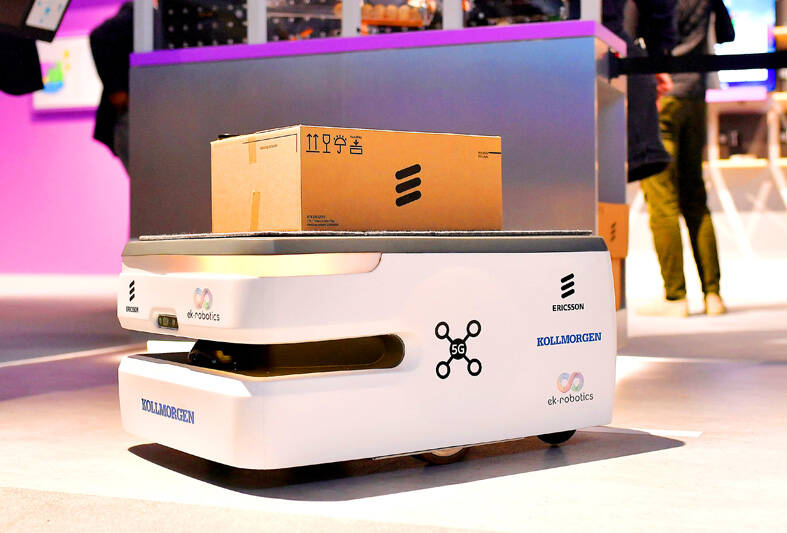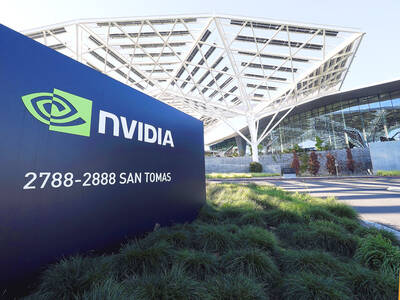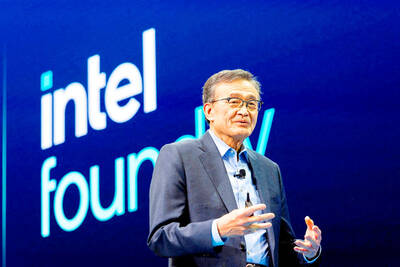Driverless vehicles, refrigerators that talk to toasters, breathtaking immersive reality, mind-blowing gaming experiences — 5G was going to enable it all, and telecoms were going to make a packet.
However, the reality is not so neat. The network that promised to be “not just another G” in Ericsson AB’s advertising has left many customers wondering what they are paying for.
Nonetheless, 5G was once again the central plank of the phone industry’s annual get-together, the MWC in Barcelona, Spain.

Photo: AFP
The event’s organizers proclaimed that 5G was “unlocking untapped value for all players across the entire ecosystem” and “redefining how the world connects.”
The hype came with a dose of reality from Orange SA chief executive officer Christel Heydemann.
Network operators were in peril, she told the MWC, because “massive network investments of almost 600 billion euros [US$640 billion] in Europe in the past decade happened to be hard to monetize.”
“And consumers expect to pay always less and get more,” she added.
Networks are not the only ones who might be rueing their big bet.
Ericsson, which supplies the equipment for 5G networks, has just laid off 8,500 people after profits slumped.
“5G has disappointed pretty much everybody — service providers and consumers, and it has failed to excite businesses,” Omdia research director Dario Talmesio said.
Talmesio said 5G was never really a consumer proposition, it was always more appropriate for businesses and industrial uses.
However, telecoms were unlikely to be seduced into investing billions only to improve connectivity in factories and ports, or help develop high-tech medical services.
Instead, they wrapped 5G in the kind of marketing that paints everything — even small improvements — as world-changing innovations.
Yet even now the benefits of 5G remain largely unclear to average smartphone users.
Thousands of US consumers told a survey last year that they were excited about the prospect of 5G, but when pressed, they had little idea what the benefits would be.
Most listed services that were already available with 4G, the survey of 10,000 US consumers by Israeli software company ironSource Ltd found.
This summarizes two of the main problems with 5G — 4G is good enough for most people, and 5G jargon is often impenetrable.
Terms like “low latency,” “network slicing,” “zero rating” and “massive IoT” are unlikely to get the pulse racing.
Despite its mass layoffs, Ericsson gave a huge floorspace at the MWC to 5G innovations, and insisted there would be no compromise on research and development.
“It is a platform for innovation. If you don’t do it, you don’t know what you miss out on,” Ericsson vice president Fredrik Jejdling said.
Frederique Liaigre, who runs Verizon Communications Inc’s business operation in France and other European countries, shares Jejdling’s enthusiasm, saying there was “no limit” to 5G’s potential.
Verizon was among the first to roll out 5G to customers in the US, and Liaigre concedes the business side is just getting started.
However, she regards her projects — such as providing a private 5G network to the port of Southampton in Britain to improve its security and supply chain management — as every bit as sexy as driverless vehicles or talking toasters.
“It’s really amazing the transformational capabilities of this technology,” she said.
Whether regular consumers will ever be so starry-eyed about 5G is up for debate.

CHIP RACE: Three years of overbroad export controls drove foreign competitors to pursue their own AI chips, and ‘cost US taxpayers billions of dollars,’ Nvidia said China has figured out the US strategy for allowing it to buy Nvidia Corp’s H200s and is rejecting the artificial intelligence (AI) chip in favor of domestically developed semiconductors, White House AI adviser David Sacks said, citing news reports. US President Donald Trump on Monday said that he would allow shipments of Nvidia’s H200 chips to China, part of an administration effort backed by Sacks to challenge Chinese tech champions such as Huawei Technologies Co (華為) by bringing US competition to their home market. On Friday, Sacks signaled that he was uncertain about whether that approach would work. “They’re rejecting our chips,” Sacks

NATIONAL SECURITY: Intel’s testing of ACM tools despite US government control ‘highlights egregious gaps in US technology protection policies,’ a former official said Chipmaker Intel Corp has tested chipmaking tools this year from a toolmaker with deep roots in China and two overseas units that were targeted by US sanctions, according to two sources with direct knowledge of the matter. Intel, which fended off calls for its CEO’s resignation from US President Donald Trump in August over his alleged ties to China, got the tools from ACM Research Inc, a Fremont, California-based producer of chipmaking equipment. Two of ACM’s units, based in Shanghai and South Korea, were among a number of firms barred last year from receiving US technology over claims they have

It is challenging to build infrastructure in much of Europe. Constrained budgets and polarized politics tend to undermine long-term projects, forcing officials to react to emergencies rather than plan for the future. Not in Austria. Today, the country is to officially open its Koralmbahn tunnel, the 5.9 billion euro (US$6.9 billion) centerpiece of a groundbreaking new railway that will eventually run from Poland’s Baltic coast to the Adriatic Sea, transforming travel within Austria and positioning the Alpine nation at the forefront of logistics in Europe. “It is Austria’s biggest socio-economic experiment in over a century,” said Eric Kirschner, an economist at Graz-based Joanneum

OPTION: Uber said it could provide higher pay for batch trips, if incentives for batching is not removed entirely, as the latter would force it to pass on the costs to consumers Uber Technologies Inc yesterday warned that proposed restrictions on batching orders and minimum wages could prompt a NT$20 delivery fee increase in Taiwan, as lower efficiency would drive up costs. Uber CEO Dara Khosrowshahi made the remarks yesterday during his visit to Taiwan. He is on a multileg trip to the region, which includes stops in South Korea and Japan. His visit coincided the release last month of the Ministry of Labor’s draft bill on the delivery sector, which aims to safeguard delivery workers’ rights and improve their welfare. The ministry set the minimum pay for local food delivery drivers at